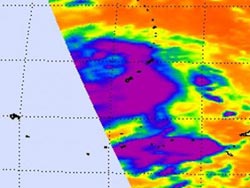NASA satellite sees Tropical Storm Sanvu pass Guam, strengthen

This infrared image of Tropical Storm Sanvu was captured from the AIRS instrument on NASA's Aqua satellite on May 22, and shows a large area of very strong thunderstorms near the center of circulation. The purple color indicates the coldest cloud top temperatures, and strongest thunderstorms with the heaviest rainfall.<br><br>Credit: Credit: NASA JPL, Ed Olsen<br>
On May 22 at 0900 UTC (5 a.m. EDT), Tropical Storm Sanvu was more than 100 miles west-northwest of Andersen Air Force Base, Guam, and still over 600 nautical miles south of Iwo To, Japan and headed in that direction.
Sanvu's center was located near 15.2 North and 141.9. East. It was still churning up rough surf around Guam. Sanvu has maximum sustained winds near 45 knots (52 mph/83 kph) with higher gusts. Sanvu is a compact tropical storm, with tropical-storm-force winds extending out 90 miles from the center, making it about 180 miles in diameter.
An infrared image of Tropical Storm Sanvu was captured from the Atmospheric Infrared Sounder (AIRS) instrument onboard NASA's Aqua satellite on May 22, and shows a large area of very strong thunderstorms near the center of circulation.
Forecasters at the Joint Typhoon Warning Center noted the AIRS imagery “shows the system has further consolidated and convection has resurged, especially along the northeast flank.”
Forecasters expect Sanvu to keep intensifying as it moves closer to Iwo To because of warm sea surface temperatures and light wind shear. Thereafter it is expected to curve to the northeast and transition to an extra-tropical storm.
Media Contact
More Information:
http://www.nasa.govAll latest news from the category: Earth Sciences
Earth Sciences (also referred to as Geosciences), which deals with basic issues surrounding our planet, plays a vital role in the area of energy and raw materials supply.
Earth Sciences comprises subjects such as geology, geography, geological informatics, paleontology, mineralogy, petrography, crystallography, geophysics, geodesy, glaciology, cartography, photogrammetry, meteorology and seismology, early-warning systems, earthquake research and polar research.
Newest articles

Silicon Carbide Innovation Alliance to drive industrial-scale semiconductor work
Known for its ability to withstand extreme environments and high voltages, silicon carbide (SiC) is a semiconducting material made up of silicon and carbon atoms arranged into crystals that is…

New SPECT/CT technique shows impressive biomarker identification
…offers increased access for prostate cancer patients. A novel SPECT/CT acquisition method can accurately detect radiopharmaceutical biodistribution in a convenient manner for prostate cancer patients, opening the door for more…

How 3D printers can give robots a soft touch
Soft skin coverings and touch sensors have emerged as a promising feature for robots that are both safer and more intuitive for human interaction, but they are expensive and difficult…




















